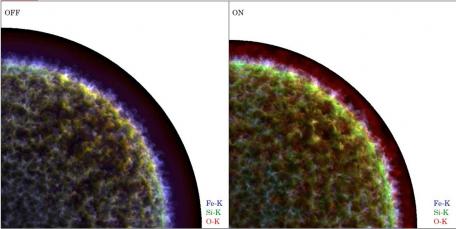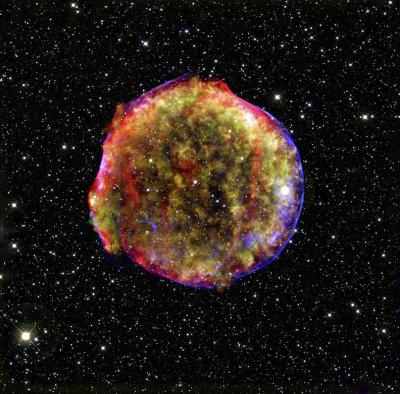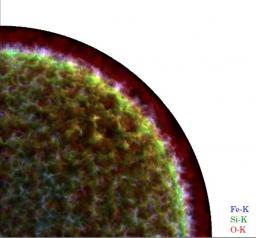An international team of astrophysicists, including Samar Safi-Harb and Gilles Ferrand at the University of Manitoba (Canada) and Anne Decourchelle from the Astrophysical Department-AIM Laboratory (CEA Saclay - France), has produced the first 3D simulations of supernova remnants (SNRs) showing the effect of particle acceleration at the wave fronts generated by these powerful X-ray sources in our galaxy. The research is published in the last issue of the Astrophysical Journal.
The prediction of the high energy emission of a supernova remnant
Safi-Harb notes: “With these simulations, we are generating the first realistic synthetic maps of projected thermal x-ray emission in young SNRs.”
Decourchelle adds: “This opens a new way to understand the physics at play by confronting high resolution 3D simulations to detailed X-ray observations of SNRs."
They note that the results will impact on astrophysicists’ interpretations of high-resolution x-ray observations, such as those currently underway using the orbiting Chandra and XMM-Newton x-ray observatories (launched in 1999 by NASA and ESA, respectively), or those planned with Astro-H (slated for launch by JAXA in 2014).

These false-colour images show the X-ray emission from various elements ejected by the supernova (iron in blue, silicon in green, oxygen in red). These synthetic images, generated from the 3D simulations, can be compared to the actual data obtained with X-ray instruments. The two sides show different scenarios for the acceleration of particles at the blast wave (OFF=un-efficient on the left, ON=efficient on the right). The presence of energetic particles significantly alters the emission from the remnant, in addition to reduce the distance between the outer blast wave (in black) and the ejected material (in color), Copyright G. Ferrand
One hundred years ago, Austrian physicist Victor Hess detected cosmic rays using a high-altitude balloon. Their origin has been a puzzle since then, but astronomers have suggested that most of these particles are accelerated by fast-moving shock waves triggered by supernova explosions. Recent x-ray and gamma-ray studies have supported this theory, but astrophysicists are not sure if protons (which make the bulk of the cosmic rays population) are also accelerated and to what energy levels.
Since magnetic fields affect the flight of cosmic rays, they arrive on earth from all directions, making it difficult to determine their origin. It is however possible to observe their likely sources in the galaxy: the SNRs, and look for signatures of their presence. The new simulations show how the efficient acceleration of particles at the shock affects both the shape and the level of x-ray emission from SNRs.

A multi-wavelength image of Tycho's supernova remnant, the result of a stellar explosion recorded over 400 years ago by the Danish astronomer Tycho Brahe. The image is a composite of an X-ray image (Chandra X-ray Observatory), an infrared image (Spitzer Space Telescope), and an optical image (3.5-meter Calar Alto telescope). Credit: X-ray: NASA/CXC/SAO; Infrared: NASA/JPL-Caltech; Optical: MPIA, Calar Alto.
Ferrand, lead author of the paper, says: “These 3D simulations, the first of their kind, will help us to unveil the presence of very energetic protons in young SNRs.”
This research was made possible by using a computer cluster devoted to these unique simulations and funded by the Canada Foundation for Innovation, as well as a supercomputer at CEA/CCRT in France. It was also supported by funds from the Natural Sciences and Engineering Research Council (NSERC) Canada Research Chair program, the Canadian Institute for Theoretical Astrophysics (CITA) and the French National Research Agency (ANR).
Contact : Anne DECOURCHELLE
see also - the University of Manitoba press release (5 Novembre 2012)
Publication :
"3D Simulations of the Thermal X-ray Emission from Young Supernova Remnants Including Efficient Particle Acceleration"
Gilles Ferrand [1], Anne Decourchelle [2], Samar Safi-Harb [1], (see the paper  PDF (5.5Mo) and arXiv:1210.0085)
PDF (5.5Mo) and arXiv:1210.0085)
[1] Department of Physics and Astronomy, University of Manitoba
[2] Service d'Astrophysique-Laboratoire AIM (CEA/Irfu, CNRS Univ. Paris VII)
• Structure and evolution of the Universe › High energy cosmic phenomena and astroparticles
• Department of Astrophysics (DAp) // UMR AIM




